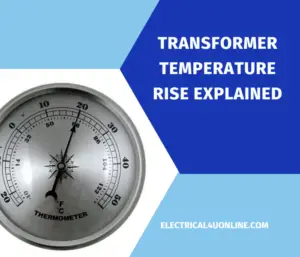Transformers are essential electrical devices used to transfer electrical energy between different voltage levels.
They play a crucial role in electrical distribution systems, industrial processes, and various applications.
One critical aspect of transformers is their power rating, which indicates their capacity to handle electrical loads.
Understanding why transformer power rating is measured in kilovolt-amperes (kVA) is important for the proper selection, operation, and maintenance of transformers.
The main reason why transformer power rating is measured in kVA is to consider both active power and reactive power, enabling efficient handling of different types of loads.
Table of Contents
Understanding Power Rating in Transformers
Power rating in transformers refers to the maximum amount of power that a transformer can handle.
It represents the capability of the transformer to supply electrical energy without exceeding its thermal limits or affecting its performance.
The power rating is typically expressed in units of kilovolt-amperes (kVA), which combines voltage and current.
Transformer Power Rating in kVA
The use of kVA for transformer power rating is based on the concept of apparent power, which considers both active power (measured in kilowatts, kW) and reactive power (measured in kilovolt-amperes reactive, kVAR).
While active power represents the actual power consumed or supplied by a load, reactive power is required to maintain magnetic fields in inductive loads.
Factors Affecting Transformer Power Rating
Several factors influence the power rating of transformers, including:
- Load Type and Characteristics: Different types of loads, such as resistive, inductive, or capacitive, affect the power rating requirements.
- Ambient Temperature: High temperatures reduce a transformer’s ability to dissipate heat, which can affect its power rating.
- Cooling Mechanism: The cooling method employed by a transformer, such as air or liquid cooling, influences its power rating.
- Overload Capacity: Transformers may have temporary overload capabilities, allowing them to handle short-duration power surges beyond their rated capacity.
Benefits of Using kVA for Transformer Power Rating
The use of kVA for transformer power rating offers several advantages:
- Handling Reactive Power: Transformers rated in kVA consider both active and reactive power, enabling efficient handling of inductive loads.
- Simplifying Power Calculations: Using kVA simplifies power calculations, especially in systems with diverse loads and varying power factors.
- Matching Loads with Transformers: kVA ratings allow for a more accurate match between the transformer and the load, ensuring optimal performance and avoiding overloading.
Determining the Appropriate Transformer Power Rating in kVA
To select the right transformer power rating in kVA, certain factors should be considered:
- Load Analysis: Assess the types of loads, their power requirements, and power factor characteristics to estimate the appropriate kVA rating.
- Consideration of Future Expansion: Anticipate future load growth or changes and select a transformer with sufficient capacity to accommodate future needs.
- Accounting for Power Factor: Determine the power factor of the load and choose a transformer with a kVA rating that considers both active and reactive power components.
Common Misconceptions about Transformer Power Rating in kVA
There are a few misconceptions regarding transformer power rating in kVA:
- kVA Rating is Not Equal to Maximum Load: The kVA rating represents the capacity of the transformer, but it should not be misunderstood as the maximum load it can handle continuously.
- Power Factor and its Impact on Transformer kVA Rating: Load power factor affects the real power component of the load. A low power factor may require a higher kVA rating to deliver the required active power.
Conclusion
Understanding the significance of transformer power rating in kVA is crucial for selecting the right transformer for specific applications.
The use of kVA allows for efficient handling of both active and reactive power, simplifies power calculations, and ensures proper matching between transformers and loads.
By considering various factors and dispelling misconceptions, engineers, and users can make informed decisions when selecting transformers, promoting reliable and optimized electrical systems.
Install my Free Android App on Google Play:
Electrical Cables Most Common Tables
And, my Electrical Calculations App “”
Discover more great content by subscribing to My channel
Looking to stay ahead of the game in the world of electrical engineering? Subscribe to my YouTube channel and gain access to exclusive content you won’t find anywhere else!
The staff I recommend
(Amazon Affiliate Links to products I believe are high quality):
- Economy 120 Volt/60Hz AC Power Source – Step-Down Voltage & Frequency Converters 1800W
- UNI-T Digital Multimeter Tester UT139C
- 50-Amp Extension Cord for RV “100ft”
- Voltage Stabilizer 110/220v
- Hair Dryer “best selling“
- TOSHIBA EM131A5C-BS Countertop Microwave Ovens
Disclaimer: This contains affiliate links to Amazon products. I may earn a commission for purchases made through these links.




